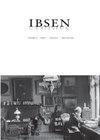Preface
IF 0.1
0 THEATER
引用次数: 0
Abstract
It seems safe to say that hardly any play in the history of world drama has had so many and such different endings as A Doll’s House. These multifarious endings have been the subject of a number of recent investigations. Christian Janss contributes to this discussion by revisiting what is arguably the most prominent of these differing endings, namely the one authored by Ibsen himself. In his article “When Nora stayed: More light on the German Ending” Janss takes issue with the myth, initially produced by Ibsen, that the person chiefly responsible for his being “coerced” into writing an alternative ending was the actor Hedwig Niemann-Raabe. According to Janss, it was, however, not her initiative nor was she a figure central enough to exert such influence. Instead, Janss’ detailed and well-researched argument illustrates how the male agents within the theatrical system can more likely be held responsible. In addition to this insightful analysis, he also reveals new evidence about the actual dissemination and use of the alternative “German” ending. Gunvor Mejdell’s article “Et Dukkehjem in Arabic Translation” also touches upon the various endings of Ibsen’s most famous play – not only in performance but also in translation. In Arabic book translations Ibsen’s original ending has been respected, even if some versions add a slightly different nuance to the play, as Mejdell demonstrates. Before getting to the textual comparisons between different translations “with focus on certain key linguistic and cultural items,” Mejdell provides a valuable literary, cultural, political and linguistic background for these translations into Arabic. She also introduces some of the challenges encountered “when trying to map Arabic Ibsen translations and their sources.” It is indeed a fact that most translations of Ibsen’s plays into this language culture have been relay translations, translated from other – mainly English – translations. This is, however, about to change with the new translations currently being published in Cairo as part of the project “Ibsen in Translation”. One issue specific to this region is the debate over which version of Arabic to choose, the classical Arabic or some前言
可以肯定地说,在世界戏剧史上,几乎没有任何一部戏剧像《玩偶之家》那样有如此多、如此不同的结局。这些五花八门的结局是最近一些调查的主题。克里斯蒂安·詹斯(Christian Janss)通过重新审视这些不同结局中可以说是最突出的一个,即易卜生本人所写的结局,为这场讨论做出了贡献。Janss在他的文章《当Nora留下来:德国结局的更多线索》中对易卜生最初制作的神话提出了质疑,即演员海德维格·尼曼·拉贝是他被“胁迫”写下另一个结局的主要责任人。然而,根据Janss的说法,这不是她的主动性,她也不是一个足以发挥这种影响力的核心人物。相反,Janss详细而深入研究的论点表明,戏剧系统中的男性特工更有可能承担责任。除了这一富有洞察力的分析外,他还揭示了关于“德语”替代结尾的实际传播和使用的新证据。Gunvor Mejdell的文章“Et Dukkehjem in Arabic Translation”也触及了易卜生最著名戏剧的各种结局——不仅在表演中,而且在翻译中。在阿拉伯语书籍的翻译中,易卜生的原始结局受到了尊重,尽管正如梅德尔所展示的那样,有些版本在剧中添加了稍微不同的细微差别。在“关注某些关键的语言和文化项目”进行不同翻译之间的文本比较之前,Mejdell为这些阿拉伯语翻译提供了宝贵的文学、文化、政治和语言背景。她还介绍了“在试图绘制易卜生的阿拉伯语翻译及其来源时”遇到的一些挑战。事实上,易卜生戏剧在这种语言文化中的大多数翻译都是接力翻译,是从其他翻译(主要是英语翻译)翻译过来的。然而,作为“易卜生在翻译中”项目的一部分,随着目前在开罗出版的新译本,这种情况即将改变。这个地区特有的一个问题是关于选择哪种阿拉伯语版本的辩论,古典阿拉伯语还是一些
本文章由计算机程序翻译,如有差异,请以英文原文为准。
求助全文
约1分钟内获得全文
求助全文

 求助内容:
求助内容: 应助结果提醒方式:
应助结果提醒方式:


